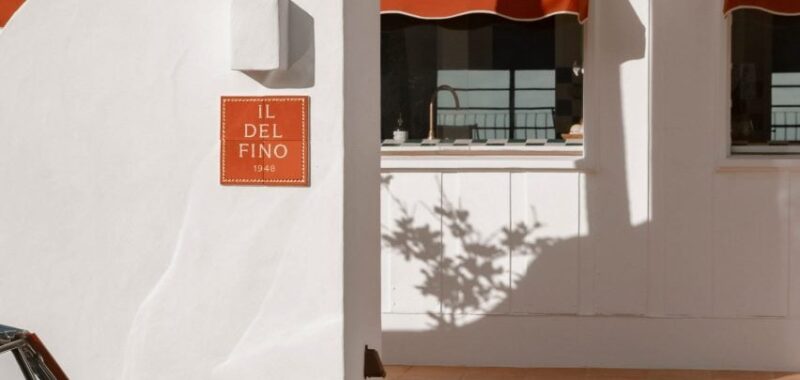
Taking design cues from her travels in the Mediterranean, designer Sheree Commerford worked with artists and craftspeople to turn a 1950s seaside inn in Yamba, Australia, into a self-check-in hotel.
Named after the Italian word for the dolphins that swim in the nearby water, Il Delfino features four suites and a stand-alone bungalow overlooking the South Pacific Ocean in the New South Wales town of Yamba.

Commerford created a Mediterranean aesthetic with whitewashed stucco walls, colourful striped fabrics, terracotta and travertine tiling, crazy paving pathways and specific landscaping, including Bougainvillaea and Cypress trees.
“Inspirations for Il Delfino lay in reminiscences of my childhood, spent here in Yamba on the verge of the ocean, together with family travels staying in old guesthouses and inns along the Mediterranean coast,” Commerford told Dezeen.

Informed by “the simple, picturesque guesthouses that line the Riviera and Amalfi Coast”, the names of the five suites reflect their Italian design inspiration – Cinque Terre, Ravello, Portofino, Ischia and Scopella.
The room names have been picked out in bespoke ceramic-tile signage by ceramic artist Elise Eales and her design studio Di Lunedi.
As well as the room names and the main Il Delfino tiles at the front of the property, Eales created directional tiles for wayfinding around the site.
Commerford worked with other local artists and designers on elements of the project.

There is a mural in every suite painted by artist Heidi Middleton, and ceramicist Lisa Lapointe created custom interior pieces, including light pendants, stools and mugs.
Lapointe collaborated with designer Monica Robinson on a pair of ceramic wall sconces in the Portofino room.
The 1948 building was one of the last remaining original structures on the oceanfront in Yamba.
When Commerford embarked on preserving the original structure, she moved into the property with her family.

“I took a crash course in knowing the space intimately – where the light settled, what leaked, what creaked, what sang, what needed love and what needed to change,” Commerford explained.
She collaborated with a team of local tradespeople, craftsmen, consultants and a landscape architect. The roof was replaced with curved terracotta tiles from France.

Commerford worked with a local blacksmith to design custom balustrades for the various balconies.
The resulting curved white balustrades were based on the style of some that Commerford remembered from a guesthouse in Puglia, Italy.
Unglazed, raw, handmade terracotta tiles from Jatana Interiors were used for the terraces, while Moroccan Zellige tiles were used for kitchen benchtops, and matching ones in a smaller size decorate the splashbacks.
“Using tiles on the benchtops was key to creating that older Mediterranean-style kitchen feel,” Commerford said.

Two different tones of tumbled travertine tiles were used on the bathroom floors “to create a more classic European feel”.
Commerford workshopped the design of the rooms by creating plywood templates for different elements, as she sought the right curves and forms with the build team.
“We’d shape and install them, seeing in real time whether they worked in the space or not,” Commerford explained.

Bespoke mirrors with custom framing were positioned in rooms “to see the ocean from many different spaces.”
“It makes me feel like I am at sea,” said Commerford.
Bedroom alcoves are separated from living spaces by heavy-weighted, striped Portuguese cotton curtains, which Commerford calls “a signature detail found in so many of the places I’ve stayed in throughout the European coastline”.
Each suite has its own unique combination of curtain colours and fabrics. Wardrobes don’t have doors, but rather curtains.

Throughout Commerford preserved and restored the original Brushbox wooden floorboards, which are a native Australian hardwood.
The floorboards were repaired in places before being tinted using a pre-colour wood wash and then sealed with an invisible plant-based wood finish by heritage wood treatment company Rubio Monocoat.

“I didn’t want them to look newly sanded and perfect,” Commerford explained. “It was really important that whatever we did, the floors had to tell the story of their age.”
“It was always a restoration, not a renovation,” she said. “Like the inn itself, the process was very old-school.”
Other boutique hotels recently featured on Dezeen include the pyramidal, coloured concrete suites of Kymaia Hotel in Mexico and the renovation by Andrea Rosso of art deco Pelican Hotel in Miami Beach.
Photography is by Anna Pihan.
The post Restored 1950s Australian guesthouse Il Delfino was designed to conjure the Mediterranean appeared first on Dezeen.

